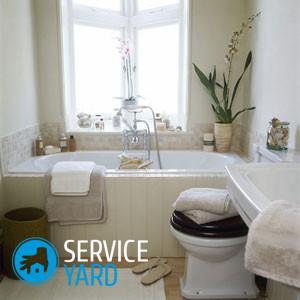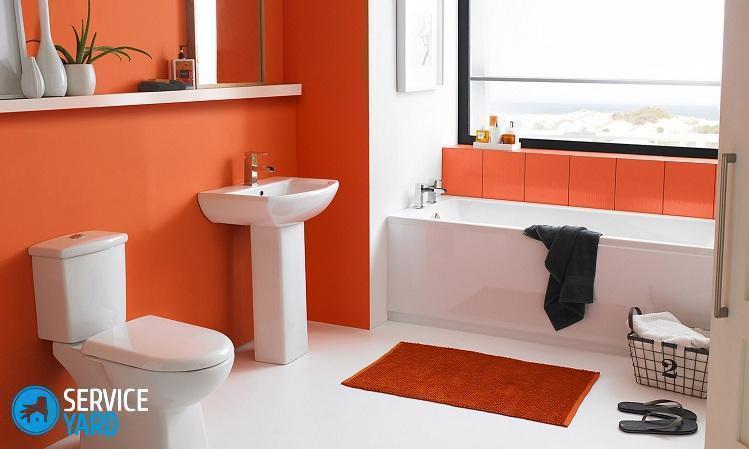Waterproof odorless bathroom paint

Repair work in your own home is quite a costly process, but without the proper selection of a professional tool and building material, it will be difficult to implement. Repair in the bathroom can be done on a budget and look for a good alternative to tiling. Waterproof odorless bathroom paint will not only save time, but also create an interesting designer interior with bright and saturated colors. In addition, by choosing the right material, you can achieve the longevity of the repair. However, it is worth knowing which particular paint for the bathroom will be the most optimal.
to contents ↑Paint selection
Paint for the bathroom must be moisture resistant. In addition, it should have antibacterial protection, as in rooms with high humidity, favorable conditions are created for the multiplication of microorganisms.
For rooms with a high level of humidity, the following types of paint can be used:
- Water-based paint - is divided into acrylic, silicone, latex and with the addition of PVA.
- Chlorinated rubber - usually used in swimming pools, because it does not allow moisture to pass through.
- Alkyd enamel - is universal, which is used for outdoor types of work and to protect metal surfaces from corrosion. Water-resistant, dries quickly due to oxidation with oxygen and forms a thin layer that perfectly flows around all the surface irregularities without streaks and traces. It has a rather unpleasant odor, therefore it is undesirable for use in residential premises.
- Oily - often used in Soviet times to decorate bathrooms. It has an unpleasant odor and dries for more than a day. Its use is possible if you do not have other means, however, it can crack quickly, and then it will be difficult to remove it from the wall.
Water-based paint for walls - which is better?
Let's take a closer look at what odorless water-based paint for walls in the bathroom is best:
- The most popular are acrylic based paints. They have a low price and perfectly envelop the surface, and are also good for use in rooms with high humidity.
- Latex paint, unlike acrylic, forms a film after drying, which additionally protects it from dirt and moisture.
- PVA-based water-based emulsion is the most budget option, it is inappropriate for bathrooms, only for ceilings in dry rooms.
- The most modern paint is silicone-based, has a waterproof structure, is not afraid of moisture. As a rule, it is used for painting facades.
to contents ↑Important! After you decide what paint to choose for the bathroom, you should choose the desired color. Usually in construction stores there are tinting machines that will help with high accuracy to get the desired shade. But it can also be done manually.
Glossy bath paints
When choosing paint for the bathroom, you should pay attention to the visual effect, which can be glossy or matte, depending on the general interior of the room:
- Glossy types of coating create a beautiful smooth surface and a mirror effect, which are often used in small bathrooms to visually expand the space.
- When deciding which paint to choose for the bathroom, it is also necessary to remember that glossy surfaces wash better, have great elasticity.
to contents ↑Important! Before you start painting the walls of the bathroom with glossy paint, remember that such a finishing coating requires a perfect smooth base, because the name gloss will emphasize all the irregularities of the wall. If the wall does not have a perfect surface, then it is better to use materials with a matte effect.
Matte bathroom paints
Matte paint has no reflection effect, it remarkably hides minor errors. In many cases, matte paint can be applied with only one layer, which will be enough to overlap the color of the base.
The choice of paint for a bathroom with a matte base should be considered, because dirt is very visible on such surfaces, and you can’t remove them with a wet rag - you will have to repaint the damaged surface again.
to contents ↑Important! When choosing the type of surface, it is necessary to take into account the area of its application: how often the surface will need to be cleaned, the type of coating will depend on this.
How to remove old paint from the walls?
In order for your repair to be durable and the coating used to please the eye, it is advisable to use the recommendations on the proper preparation of the wall surface before applying the selected odorless waterproof paint for the bathroom.
Necessary tools
There are many tutorials on how to remove paint from the surface of the walls of the bathroom before applying odorless paint to the walls in the bathroom:
- Special chemical solvents to be used on the treated surface.
Important! All chemicals have a rich pungent odor, so you need to refrain from processing small rooms or use special masks.
- Removing an old coat of paint with a hair dryer or curling iron is a rather traumatic method of cleaning walls. In addition, toxic steam will form during the heating of the coating.
- Electromechanical cleaning method using a grinder or drill. A special nozzle is put on any of these tools, which will qualitatively remove the finish layer. For a good result, it is necessary to select a brush of the necessary stiffness, with which the existing amount of coating will be removed.
Important! This method is the most effective for cleaning the walls of the old coating, but at the same time, it is the most noisy and leaves behind a large amount of dirt and dust.
Surface preparation technology
If you want the coating to hide irregularities, and the painting process does not take much time, you need to understand how to remove old paint from the walls of the bathroom, in what ways it can be done. The main stages, which include the entire cleansing process, are as follows:
- Remove previous coat with emery floppy disk, scrapers, putty knife or special solvents.
- Eliminate the dust that has formed after removing the paint coat with warm water.
Important! Be sure to smooth the walls and use acrylic putty to eliminate defects - this will protect the surface from the penetration of dirt and increase the long-term coverage.
- Use sandpaper and remove any bumps.
- Use copper sulphate or bleach to eliminate mold or mildew, if any.
- Treat the walls with a latex primer in 3 layers.
to contents ↑Important! With each coating layer, you must wait until complete drying.
Painting
After a thorough preparation of the walls, the most interesting and responsible work on painting them remained.This process will captivate anyone from the first minute. But for a good result, you should use only the best paint for the bathroom.
Tips for doing the job:
- It is advisable to apply paint in 2 layers. The first part of the composition can be diluted with water. It should be no more than 15% of the total volume.
- Excess must be removed from the tool so that it does not transfer to the wall. A tray with grooves is perfect for these purposes. Paint is poured onto its bottom, a roller is moistened in it, which is then rolled into grooves. Neglecting this recommendation, you will have to fight all the time for smudges that can turn the creative process into exhausting work.
- To ensure that the paint does not fall on unnecessary areas, use masking tape. With it, you can create smooth color transitions from dark to light shade.
- Surface painting begins with corners and hard-to-reach areas. After that, they proceed to finish the entire surface. If there are bumps, it is better to apply the first layer with a brush, then it will come out more dense.
- The second layer is applied by roller. Do this after the first layer has completely dried.
Important! Having bought white paint with color, you should mix it in large quantities so that it is enough for all walls. If you have purchased several cans of paint of a finished color, it is better to mix them in one container, because they may vary in shade. You may not notice this in the bank, but the difference will certainly be visible after the walls dry.
The choice of tools for painting
For the painting of walls, various types of tools can be used: spray gun, roller, brush. Waterproof odorless bathroom paint will perfectly cover the walls with any of the listed tools, although each of them has its own characteristics:
- Brush - able to densely cover the surface, but its use increases paint consumption. You can buy it at any store and at a low price.
- Roller - perfectly applies the composition to flat surfaces. It distributes paint well and very economically. However, for processing corners and various irregularities, you still have to use a brush. For water emulsion composition, felt rollers are well suited.
Important! The width of the roller should be selected according to the staining area. The larger the area, the wider the roller.
- Spray gun - most evenly and efficiently applies the composition. However, it alone requires careful care. After each use, it must be washed well.
to contents ↑Important! With a single painting of a small area, it is better to do with a brush or roller. This will provide an opportunity to save on tools. In addition, they are perfectly washed off from water-based paint and can be reused in other work.
Stock footage
Painting the walls with waterproof odorless bathroom paint is an inexpensive, fairly simple, but at the same time, effective way to update the interior. Using high-quality materials and tools, as well as carefully preparing the surface, you will get the perfect result. Show your imagination and create a unique design!
- How to choose a vacuum cleaner taking into account the characteristics of the house and coatings?
- What to look for when choosing a water delivery
- How to quickly create comfort at home - tips for housewives
- How to choose the perfect TV - useful tips
- What to look for when choosing blinds
- What should be running shoes?
- What useful things can you buy in a hardware store
- Iphone 11 pro max review
- Than iPhone is better than Android smartphones




